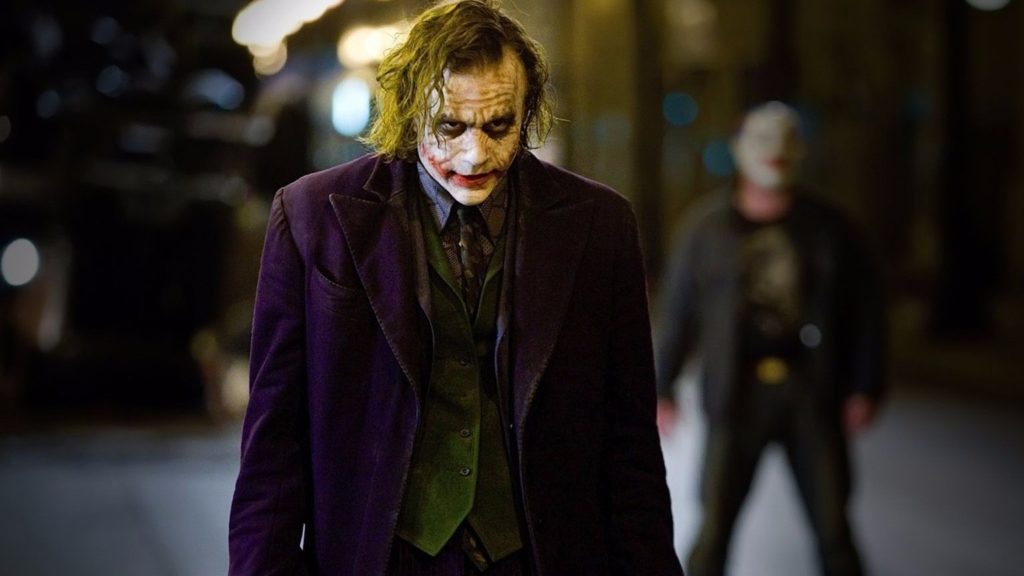
Sometimes folks look for trouble. And sometimes trouble comes a callin’, all on its own.
For a while, it seemed as though life in Gotham City was looking up. Gotham’s finest, led by straight-arrow Lt. Gordon, was squeezing the city’s crime syndicates. Harvey Dent, a new and fearless district attorney, stalked the courtrooms. Batman prowled the city’s darkest alleys. Mob bosses stopped meeting at night, afraid they’d be pinched.
What? A city where crime kingpins are afraid of the dark?
Then—like the flu, like a hailstorm, like a crowbar to the side of the head—comes the Joker. No baggage. No backstory. No greedy motive. Just a leering, cackling demon of chaos. He crashes a high-level mob meeting and offers his services as the city’s very own bat exterminator. What does he want? Nothing. Everything. What does he ask for? Half the mob’s money.
“If you’re good at something,” the Joker wheezes, “you never do it for free.”
So begins perhaps the deepest, bleakest summer blockbuster ever, an explosion-riddled saga about order and anarchy, about good and evil, and about the line we draw between the two.
[Note: To explore this film’s philosophical and spiritual underpinnings, the following sections contain plot spoilers.]
The Dark Knight is a complex film with a myriad of messages. But at its most basic, the question it poses is this: To what lengths do good people go in order to conquer the worst sort of evil? Must they become a little evil themselves along the way?
“You got rules!” a broken mob boss tells Batman. “The Joker—he’s got no rules!”
It’s a pesky truism our heroes struggle with from the get-go. None of them escape unsullied. “You either die a hero or live long enough to see yourself become the villain,” says Dent. But it’s when they refuse to compromise that the movie soars.
Dent starts as a bright knight—a blond, bold DA who aims to clean up Gotham’s streets for good. Though there are ever-so-slight indications that he’s not altogether wonderful (the boys at the station call him “Two Face”), he’s sincere about his crime-fighting calling—a sincerity that wins over even billionaire-celebutant Bruce Wayne. “Gotham needs a hero with a face,” Wayne says. One might say Dent and Batman are two sides of the same coin, Dent the unsullied face of incorruptibility and Batman the black-caped heavy. Dent even sacrifices his career and good name at one point to keep Batman out on the streets—a favor Batman returns.
Lt. Gordon, once Gotham’s only honest police officer, has a wee bit of company nowadays, but he’s still arguably the film’s finest, prepared to sacrifice his own life for both his city and family.
Lucius Fox, head honcho at Wayne Enterprises, continues to play Q to Batman’s Bond, keeping him supplied with a host of critical gizmos and gadgets. But while he’s willing to cook the books to keep Batman’s identity a secret, there are ethical places he won’t go—at least not for very long. When the Dark Knight creates a gigantic sonar net by tapping into all of Gotham’s cell phones (a hefty invasion of privacy), Fox tells him that either the machine goes or he does. “Spying on 30 million people isn’t in my job description,” he says—though he acquiesces to use it for one specialized mission.
The most heroic guy of the bunch (go figure) is Batman himself, willing to sacrifice everything that’s precious to him for the sake of the city. He never, ever kills, and he rigidly keeps this special vow even when the Joker more than deserves death.
The citizens of Gotham also show a bit of gumption. When the Joker pits average Joes and Janes against convicted killers and thieves in a deathmatch of sorts, they manage to resist their selfish urges and risk everything to do the right thing. Humanity and its higher conscience survives even as the world burns down around it—much to the Joker’s dismay.
The Dark Knight is loaded with pseudo-spiritual themes and philosophical musings (which I’ll explore in my conclusion), but it’s devoid of overt references to faith.
Bruce Wayne lives up to his pampered playboy rep. Groupies wear low-cut evening gowns, and ballet dancers wear bikinis when Wayne spirits away the entire Russian Ballet to his private yacht. We see a couple straightening their clothes when they’re startled during a secret tryst.
The Joker leers at Rachel—who is, incidentally, a former paramour of Bruce Wayne and current main squeeze of Harvey Dent. This love triangle adds a bit of sexual tension to the film, but only a bit.
Harvey Dent loses half of his pretty face just as the action climaxes. What remains is a charred, horrific visage of sinew and bone: His left eye is lidless and the left side of his mouth is lipless, exposing the teeth beneath.
This is the film’s most overt display of graphic ickiness. Truth be told, The Dark Knight is not gory, though. The carnage here is felt, not seen.
But oh, how we feel it.
The Joker is as horrific a villain as I’ve ever seen onscreen—an embodiment of nihilism, a manifestation of pure, unapologetic evil. The camera may blink, but your mind’s eye doesn’t. The Joker forces us to imagine every cut and tear. He makes Jigsaw from the torture-porn Saw flicks look positively ethical, and frankly, I think I squirmed more through Knight than through the splatter-happy Saw IV. Why? The violence here feels more real, visceral … painful.
We watch as the Joker impales a man’s face with a pencil, as he burns a sky-high pyramid of cash with a financier imprisoned at the apex, as he shoots and stabs and burns his way through the movie. He plants a bomb in the stomach of one of his imprisoned henchmen, setting it off to escape from jail. He joyfully blows up a hospital, poisons a police officer, bazookas a police vehicle and guns down his own henchmen.
Forget the big bangs, though. This Joker’s weapon of choice is the knife: He carries several, one of which he sticks in his victims’ mouths as he tells them stories (all, apparently, lies) of how he got his own “smiling” scars before slicing their faces open. We never see him cut, but the stories—the brutal, mesmerizing stories—are enough. They are more than enough.
That said, I’m not going to detail every bit of violence seen onscreen in this not-really PG-13 movie. Batman pummels dozens of folks, but you knew that would be the case before you started reading. There are car chases, crashes and explosions aplenty, but you knew that, too.
What you might not know is that the Joker kills scores of folks, and all the death that surrounds him only seems to brighten his mood. Counting casualties doesn’t convey how you might feel as you watch, and how you’ll feel walking out when it’s over. So I’ll put things this way: The Dark Knight is not Iron Man, not Hancock, not even Hellboy II. This is a movie about a cartoon hero. But there’s nothing cartoonish about it.
Characters abuse Jesus’ name three times, God’s name a half-dozen times (once, pairing it with “d–n”). They lob a handful of other curses, including “h—” and “a–.”
Bruce’s party guests drink champagne. Alfred offers Harvey a glass, calling it “liquid courage.” A cop sips a drink in a bar. Whiskey is downed.
The Dark Knight refers, of course, to Batman. But all of the film’s good guys dabble in the gray areas of life, and none (well, maybe one) escape(s) this film with a clean ethical bill of health.
Batman purposefully breaks the legs of a would-be informant to make him talk. And he pummels the Joker in a police holding cell—going so far as to bar the door with a chair so the police won’t interfere. Gordon is reticent to communicate with his supervisors and deceives even his own family. Fox develops all of Batman’s cool weaponry off the books, circumventing financial transparency at every turn. Dent, even before he goes bad, flips a coin to determine a course of action. Turns out it’s a two-headed coin—an act of duplicity that foreshadows his fall.
None of these actions are directly lauded by the film, though its makers do take pains to show why these less-than-ethical dealings could be justified. Instead, these scenarios are designed to stir questions in the audience, not provide it with answers. In this Dark Knight, evil is absolute. Good? Not so much.
The Dark Knight poses and plays with ethical conundrums, most of which seem designed to push Batman, his allies and all of Gotham over the brink. “Madness, as you know, is like gravity,” the Joker says. “All it takes is a little push.”
The Joker succeeds in transforming Dent into a vicious villain with (quite literally) a two-sided face, and then sits back as his pet project flips that coin (one side now charred and scarred) to determine who dies and who lives. “The only morality in an amoral world is chance,” Dent says.
Batman argues that the world’s not governed by chance, but by choices. And when Dent dies, Batman makes the movie’s most interesting choice of all: He takes the blame for the people Dent killed. He becomes, unjustly, a fugitive hated by the very people he’s protecting.
“Sometimes, truth isn’t good enough,” Batman says. “Sometimes people deserve more. Sometimes people deserve to have their faith rewarded.”
The decision, like Dent himself, shows us two faces.
On one side of it, Batman creates a lie—a flat-out fabrication that patronizingly presumes he knows what’s best for Gotham’s citizens, and that they’re too fragile or shortsighted to accept the truth. In an age when we are all wary of lies, deceptions and governmental cover-ups, this kind of fabrication (well-meaning though it may be) feels especially wrong and, in any case, always violates one of God’s core commandments: Don’t lie.
On the other, Batman takes Dent’s sin on his own shoulders, leaving the DA, in Gotham’s eyes, pure and spotless and clean. Sound familiar? It can be read, at some level, as an echo of the sacrifice Christ—utterly innocent, yet humiliated and judged on our behalf—made for us.
One more thing to chew on: Batman, in Bruce Wayne’s mind, is not a hero, but an ideal—a symbol for something greater. People, he muses in Batman Begins, are corruptible. Ideals are not. It stands to reason, then, that he would want to push Dent from corruptible man to incorruptible ideal—a symbol of something greater. “Gotham needs a hero with a face,” Wayne says. And so he gives that hero to the city, willingly destroying his own reputation in the process.
Without a doubt, then, The Dark Knight is mesmerizing and thought-provoking. It’s guaranteed to become a critical darling while scooping up a bazillion dollars at the box office. But its dark side cannot be ignored. The Chicago Tribune leads its review with this warning: “Sensational, grandly sinister and not for the kids.” The New York Daily News tells us, “The PG-13 rating seems tame; this sucker is rough.” You’re seeing it advertised on everything from cereal boxes to candy bars, but that doesn’t make Knight‘s violence, it’s aura of menace, any more digestible. It’s not just kids who’ll walk out of the film shaken.
When you see Harvey Dent’s new look for the first time, you barely notice his still pretty-boy right side. The left side—charred, unblinking, horrific—seems to fill the screen. And the same could be said for this movie. Yes, it’s undeniably well-crafted. But it’s a harsh creation, and by all rights shouldn’t have been named after the good guy. The Dark Knight is the Joker’s court, and he’s not looking for a laugh.


Paul Asay has been part of the Plugged In staff since 2007, watching and reviewing roughly 15 quintillion movies and television shows. He’s written for a number of other publications, too, including Time, The Washington Post and Christianity Today. The author of several books, Paul loves to find spirituality in unexpected places, including popular entertainment, and he loves all things superhero. His vices include James Bond films, Mountain Dew and terrible B-grade movies. He’s married, has two children and a neurotic dog, runs marathons on occasion and hopes to someday own his own tuxedo. Feel free to follow him on Twitter @AsayPaul.